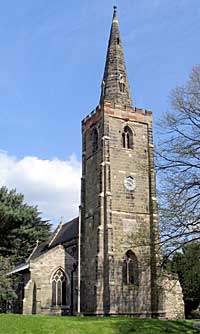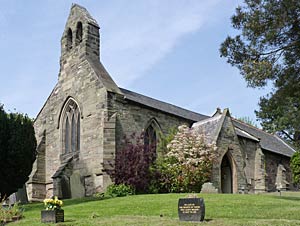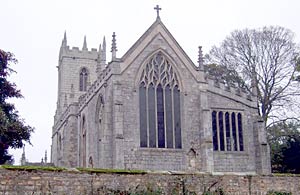< Previous | Contents | Next >
Two Famous Naval Men
SUTTON BONINGTON. One village made out of two, with the churches of old Bonington and Sutton, it rests on a slope of the Soar Valley, looking across the river into Leicestershire. As we gravel its pleasant mile-long road we find reminders of men who linked this place with great events in distant seas, and with one of the heroic achievements of our race.
At one end of the village is the gabled Hobgoblins, now two dwellings with something of an ancient house of the monks of Repton Priory; at the other end is a quaint old house with the upper storey of timber and fine herringbone overhanging the lower storey of Charnwood Forest stone. Halfway down the street is a tiny black and white cottage whose beams rise from ground to gable like a great letter A.

St Michael's church, Sutton Bonington, in 2006.
Facing this cottage, St Michael's Church stands back from the road in a terraced churchyard. The tower and its lofty spire, rising to 135 feet, come from the close of the 14th century; the south arcade is 13th century, the north arcade and much of the aisles are 14th, and the fine clerestory is 15th. There are stone seats round some of the pillars. The most interesting possession is the 600-year-old font carved with quatrefoils, its unusual feature being three projecting brackets, level with the rim. The oldest relic is part of a 12th century coffin stone in the outside wall near the modern porch.
The chancel was made new last century. There is good modern woodwork (including the screen and the stalls), and beautiful glass which sheds a rich glow. Among the windows in memory of the Pagets of Sutton Hall is one with St Michael and St George, to a soldier who died from wounds in the Transvaal. One with the Women at the Tomb is to Ralph Owen Yearsley, who in, 1913 ended 47 years as vicar here.
Two memorials in this quiet church, a brass tablet and the pews, relate to a wider world; both are the gifts of one woman, married in turn to two famous figures who found a haven here from the perils of the sea. The tablet is to Admiral Sir William King-Hall, who, born a year after Waterloo, joined the navy at 13 and served in every sea, winning great distinction in the Chinese War of 1856. A deeply religious man, he conducted services aboard, advocated total abstinence before it was popular, and promoted charitable organisations.
His widow continued to live here after his death, and in 1894 married Sir Alexander Armstrong, a second hero the village came to know. A naval surgeon, he sailed in the Investigator in the middle of last century, searching for the lost Franklin expedition and, having passed along the North Coast of America from the West, reached Banks Land, from whose north-eastern corner the ice was crossed to Melville Island, and the long-sought North-West Passage at last achieved. Armstrong, who had helped to keep the crew alive for years in the Arctic, died here in 1899. His widow reseated the church in his honour.

St Anne's Church, Sutton Bonington, in 2014.
© Copyright Alan Murray-Rustand licensed for reuse under this Creative Commons Licence.
The tiny towerless church of St Anne nestles high on the hillside, with an ancient bell swinging in the gable. What is left of the old church (after much restoration last century) is 14th century, the time of the nave arcade, the piscina in the chancel, and the font. In a recess in the chancel lies a knight in 15th century armour, a giant seven feet long with his feet on a lion; he was called Old Lion Grey. His identity is uncertain, though his collar of suns and roses assures us that he was a Yorkist.
Admiral King-Hall lives on in memory here, as at St Michael's, a window to him showing Christ walking on the sea with Peter, a miracle he must often have expounded to stay the troubled minds oi his men beset by tempests in far latitudes.
The glory of this little church is its lovingly tended garden of roses, lawn, and trees, where we look over the village to the hills of Charnwood Forest.
The Village Queen of Sheba

St. Bartholomew's Church, Sutton-cum-Lound, in 2011.
© Copyright JThomas and licensed for reuse under thisCreative Commons Licence.
SUTTON-CUM-LOUND. It has little but its church, but that is much. It stands with limes and sycamores above the village. Its 15th century tower, with eight pinnacles and a lofty arch, has two bells which have been ringing since before the Armada. The stone-roofed porch and the rest of the walls are all embattled, and are adorned with pinnacles and a gallery of sculptured heads. Some are cunningly, fashioned at the foot of the pinnacles.
The old doorway through which we enter has the original folding door with its old plate and ring. Over the doorway is a round arch which seems to be Norman. A beautiful 14th century arcade divides the nave from the aisle, and a similar arcade is between the chancel and its chapel. The lofty Norman chancel arch has been rebuilt, three lovely sedilia and a piscina are medieval, and a fine founder's recess has a feathered arch with pinnacles and a finial.
Three poppyheads of 23 old bench-ends are carved with an eagle, a happy-looking angel, and the trim head of a lady the villagers call the Queen of Sheba. The handsome bands of vine carving in two old benches in the chancel belonged to the old chancel screen, and remains of a 15th century screen are in the modern screen of the chancel chapel. An old pillar almsbox has three locks, an oak chest is 17th century, and another chest is shaped from a solid block of oak, its small cavity covered by a heavily iron-banded lid which is secured by an iron bar on the front of the chest. At the ends of the hammer-beams of the modern roofs of the nave and chancel are stone heads, most of them crowned.
A brass inscription tells of John Farmer, who was vicar here for nearly half a century, both he and his wife dying in 1921.
At Barnby Moor, a mile from Sutton on the Great North Road, is a famous old posting house known to every traveller between London and York before the coming of the railway. Known as the Bell Inn, it became for many years a private house, and part of it even a chapel, but it is now brought charmingly up-to-date as a hotel.
